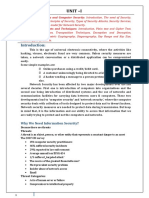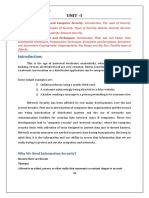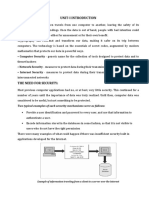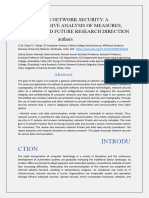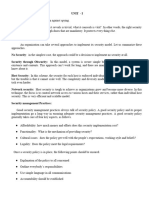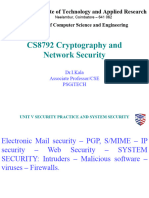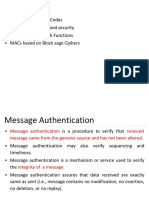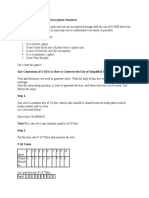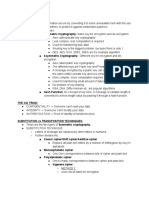C&NS Unit-1
Uploaded by
abhivivek68C&NS Unit-1
Uploaded by
abhivivek68Cryptography and Network Security UNIT-1
INTRODUCTION
Syllabus: UNIT- I: Basic Principles
Security Goals, Cryptographic Attacks, Services and Mechanisms, Mathematics of
Cryptography
Information Security plays a vital role in today’s world of communication, military operations,
and in financial organizations, .. etc. Information in the wrong hands can lead to a major loss
of country, business or any organization. Before the wide spread use of electronic
communication, the security of information is valuable to an organization and it is provided
by means of physical and administrative. Physical security of information is by providing
lockers to store the sensitive documents. Information can also be secured by screening the
employee while hiring. A disgruntled employee can leak company’s sensitive information to
the outside world.
The requirements of information security in an organization have undergone two major
changes in the last several decades.
1. The first change occurred with the introduction of computers. Due to this, there is a
need to develop automated tools and s/w for protecting information stored in the
computer. This is required more for shared systems, and for systems which can be
accessed over a public telephone network. The collection of tools designed to protect
data and to thwart (prevent) hackers is computer security.
2. The second change occurred with the introduction of distributed computers and the
use of networks and communications facilities (routers, gateways) to transport data
from one user to another. Therefore Network Security measures are needed to
protect data during the transmission.
There are no clear boundaries between these two forms of security. The most popular
attack on information systems is the computer virus. A virus may be introduced into a
system physically using a diskette (any storage device), or it may also arrive over an
internet. In either case, once the virus is identified, internal computer security tools are
required to detect and recover from the virus.
Dr. Kalavathi A, Professor & HoD IT 1
Cryptography and Network Security UNIT-1
Security Violations:
1. User A transmits a confidential file to user B. this file contains some sensitive
information that are to be protected from disclosure. An unauthorized user C may
capture a file during it’s transmission.
2. A network manager, D, transmits a message to a computer, E who is working under
him. The message instructs E to update the authorization file and their access
privileges,
3. Instead of intercepting a message, a user F constructs his own message and transmits
to E, as if the message come from the network manager D.
4. In case of employee firing without any warning or notice, the personal manager sends
a message to a server system to invalidate the employee’s account. After the
invalidation, server posts a notice to the employee for confirmation of the action.
Employee intentionally delays to give confirmation so that he can get final acces to
the server to retrieve sensitive information.
5. A message is sent from a customer to a stock broker to sell all his shares.
Consequently, suppose if shares price goes down, customer denies sending the
message.
These are the possible types of security violations, these illustrates the range of concerns
of network security. Internetwork security is both interesting and complex.
The Three Aspects of Security:
To assess the security needs of an organization effectively, and to evaluate and choose various
security products and policies, the following three aspects of information security are
considered
1. Security Attack: An action which compromises the security of information owned by
an organization. This is an assault against a computer or network infrastructure
2. Security Mechanism: a mechanism that is designed to detect, prevent and recover
from security attacks.
3. Security service: A service that enhances the security of information systems and data
transmission of any organization
Dr. Kalavathi A, Professor & HoD IT 2
Cryptography and Network Security UNIT-1
OSI Security Architecture: ITU-T (International Telecommunication Union
Telecommunication Standardization Sec Recommendation X.800, Security Architecture for
OSI defines systematic way to
• Defining the requirements for security
• Characterizing the approaches to satisfying those requirements.
The OSI security architecture is useful to managers as a way of organizing the task of providing
security. Furthermore, because this architecture was developed as an international standard,
computer and communications vendors have developed security features for their products
and services that relate to this structured definition of services and mechanisms. These can
be defined briefly as follows:
Threats and Attacks (RFC 2828)
Threat : A potential for violation of security, which exists when there is a circumstance,
capability, action, or event that could breach security and cause harm. That is, a threat is a
possible danger that might exploit a vulnerability.
Attack: An assault on system security that derives from an intelligent threat; that is, an
intelligent act that is a deliberate attempt (especially in the sense of a method or technique)
to evade security services and violate the security policy of a system.
Dr. Kalavathi A, Professor & HoD IT 3
Cryptography and Network Security UNIT-1
Security Services: Computer and network security research and development have focused
on general security services that encompass the various functions required for information
security. ITU-T has defined 6 types of security services
1. Confidentiality: The general meaning of confidentiality is the state of keeping or being
kept secret or private. Ensures that the information in a computer system and
transmitted information are accessible only for authorized users.
Ex: Access types includes: read, print, display and other forms of disclosure.
Disclosure: Revealing the contents of a message
2. Authentication: This is a process or action of verifying the identity of a user or person.
Ensures that the origin (source) of a message or electronic document is correctly
identified with an assurance that the identity is not false.
3. Integrity: The general meaning of it is the quality of being honest and having strong
moral principles. Ensures that only authorized parties are able to modify computer
system assets and transmitted data. And also ensure that the data has not been
modified by anyone (third person, intruder) and anywhere else in the network.
Ex: Modification includes: writing, inserting, changing, deleting, creating, appending
and delaying or replaying of transmitted messages.
The various types of Integrity is:
4. Nonrepudiation: It is the assurance that some one cannot deny something. It refers
to the ability that a party to a contract or a communication cannot deny the authenticity
of their signature on a document or the sending of a message that they originated. In
other words, neither the sender nor the receiver of a transmitted message be able to
deny the transmission or reception
The various forms of Nonrepudiation are :
Nonrepudiation, Origin: Proof that the message was sent by the specified party.
Nonrepudiation, Destination: Proof that the message was received by intended
receiver.
5. Access Control: It is the selective restriction of access to an information resource or
information. Permission to access a resource is known as authorization. The
prevention of unauthorized use of a resource (i.e., this service controls who can have
access to a resource, under what conditions access can occur, and what those
Dr. Kalavathi A, Professor & HoD IT 4
Cryptography and Network Security UNIT-1
accessing the resource are allowed to do). Access privileges to the information system
are:
Ex: Write, Read, Execute, Save
6. Availability: It requires that computer system assets be available to authorized users
whenever needed.
Security Mechanisms: There is no single mechanism that will provide all the security services.
One of the most specific security mechanisms in use is cryptographic techniques. Encryption
or encryption-like transformations of information are the most common means of providing
security. Some of the mechanisms are:
1. Enciphering and Deciphering
2. Digital Signature
3. Access Control
Security Attacks: According to G.J. Simmons information security deals with how to prevent
cheating, or failing that, to detect cheating in information based systems where information
has no meaningful physical existence. Attacks on the security of a computer system or
network are best characterized by viewing the function of the computer system as providing
information.
In general there is a flow of information from a source to destination. This normal flow
is depicted in the following figure.
Security attacks are categorized into four types:
1. Interruption: Information assets may be destroyed or becomes unavailable or
unusable. This attack happens on the lack of availability service.
Ex: destruction of a piece of hardware like hard disk, cutting the communication line,
or disabling file management system.
Dr. Kalavathi A, Professor & HoD IT 5
Cryptography and Network Security UNIT-1
2. Interception: An unauthorized party gains access to the resources. This is an attack on
confidentiality. The unauthorized party may be a person, a program or a computer.
Ex: Wiretapping, air tapping, illicit copying of files or programs.
3. Modification: An unauthorized party gains access and tampers information assets.
This attack is on Integrity service.
Ex: changing values in a database, altering a program, modifying the contents of a
message.
4. Fabrication: An unauthorized party inserts forged objects into the system. This attack
is on authenticity.
Ex: inserting fake messages in a network or addition of records in a file.
These four types of attacks are further categorized into passive and active attacks.
Dr. Kalavathi A, Professor & HoD IT 6
Cryptography and Network Security UNIT-1
Passive Attacks: These attacks comes under the category of eavesdropping and monitoring
of transmissions. In this case the goal of opponent is to obtain transmitted information. There
are two types of passive attacks:
i) Release of Message Contents: Any telephone conversation, a transmitted file, an
e-mail message may contain confidential information. The opponent will try to
capture the message and reveal the contents of transmitted message
ii) Traffic Analysis: In case of a protected message, opponents, even if they capture,
they could not extract the contents of a message. But still the opponent can
observe the traffic these messages. Opponent can also determine the location and
identity of communicating hosts (means source and destination) and could
observe the frequency and length of messages being exchanged.
These passive attacks are very difficult to detect because they do not alter the contents of
message. But measures are available to prevent these attacks.
Active attacks: These attacks involve modification data stream or the creation of a fraudulent
data. These are further classified into masquerade, replaying, modification of messages,
denial of service.
Masquerade: This attack takes place when one user pretends like another user. In terms of
communications security issues, a masquerade is a type of attack where the attacker pretends
to be an authorized user of a system in order to gain access to it or to gain greater privileges
than they are authorized for.
Dr. Kalavathi A, Professor & HoD IT 7
Cryptography and Network Security UNIT-1
Replay: A replay attack (also known as playback attack) is a form of network attack in which
a valid data transmission is maliciously or fraudulently repeated or delayed. Replay attacks
are the network attacks in which an attacker spies the conversation between the sender and
receiver and takes the authenticated information e.g. sharing key and then contact to the
receiver with that key. In Replay attack the attacker gives the proof of his identity and
authenticity.
Ex: Suppose in the communication of two parties Bob and Alice; Bob is sharing his secret key
to Alice to prove his identity but in the meanwhile Attacker Darth eavesdrop the conversation
between them and keeps the information which are needed to prove his identity to Alice.
Later Darth contacts to Alice and prove its authenticity.
Modification of messages: In a message modification attack, an intruder alters packet header
addresses to direct a message to a different destination or modify the data on a target
machine.
Ex: Allow Ram to read confidential file is modified to
Allow Shyam to read confidential file.
Dr. Kalavathi A, Professor & HoD IT 8
Cryptography and Network Security UNIT-1
Denial of Service: In a denial of service (DoS) attack, users are underprivileged of access to a
network or web resource. It prevents the normal use or management of communications
facilities. Another form of denial of service is disruption of an entire network, either by
disabling the network or be overloading it with huge number of messages so as to degrade
performance.
Network Security Model: A message is transmitted from one party to another across the
Internet. The two parties, who are principal communication parties in this scenarios, must
cooperate each other to transmit data. A logical channel is established between the two
parties using TCP/IP.
Security aspects are applied when it is necessary to protect information transmission
from an opponent (third party) who may attack on confidentiality, authenticity, and any
service.
Dr. Kalavathi A, Professor & HoD IT 9
Cryptography and Network Security UNIT-1
A trusted third party is required to achieve secure transmission. A third party is responsible
for distributing the secret information to the two principals. This general model performs
four basic tasks:
1. Design an algorithm for performing secure transmission
2. Generate the secret information to be used with the designed algorithm
3. Develop methods for distribution and sharing of secret information
4. Specify protocols which are used by two principals for secure transmission
To protect information systems from unwanted access, the following network access security
model is used:
An opponent may be a human or software. Hackers attempt to penetrate a systems that can
be accessed over a network. Hacker is a person who uses computers to gain unauthorized
access. In computing, a hacker is any skilled computer expert (programmer) that uses their
technical knowledge, uses bugs or exploits to break computer systems.
A software program, can present two types of threats:
1. Information access threats: Interception and modification of messages on behalf of
unauthorized users who do not have access to that data.
Dr. Kalavathi A, Professor & HoD IT 10
Cryptography and Network Security UNIT-1
2. Service threats: These threats exploit service fa in computer to prevent use by
legitimate user
Virus and worms are two examples of service threats.
Virus attacks can be introduced into a system by copying or downloading a file from a diskette
or from any web server. Whereas worms can be inserted into a computer across a network.
Computer worms are similar to viruses in that they replicate functional copies of themselves
and can cause the same type of damage. In contrast to viruses, which require the spreading
of an infected host file, worms are standalone software and do not require a host program or
human help to propagate. A worm is a special kind of computer virus that propagates by self-
replication over a computer network. This propagation can be either via e-mail or other
means such as files being copied over a network.
Computer Virus Computer Worm
How does it infect a It inserts itself into a file or It exploits a weakness in an
computer system? executable program. application or operating
system by replicating itself.
How can it spread? It has to rely on users It can use a network to
transferring infected replicate itself to other
files/programs to other computer systems without
computer systems. user intervention.
Does it infect files? Yes, it deletes or modifies files. Usually not. Worms usually
Sometimes a virus also changes only monopolize the CPU
the location of files. and memory.
whose speed is virus is slower than worm. worm is faster than virus.
more? E.g. The code red worm
affected 3 lack PCs in just 14
Hrs.
Dr. Kalavathi A, Professor & HoD IT 11
Cryptography and Network Security UNIT-1
Computer Virus Computer Worm
Definition The virus is the program code The worm is code that
that attaches itself to replicate itself in order to
application program and when consume resources to bring
application program run it runs it down.
along with it.
The security mechanism required to prevent above two threats is to use gatekeeper function
and internal security controls. The first, gatekeeper function use password based login
procedures to allow only authorized users. The second one internal security controls monitors
the activity and analyse the stored information to detect the presence of unwanted intruders.
Dr. Kalavathi A, Professor & HoD IT 12
Cryptography and Network Security UNIT-1
MATHEMATICS OF CRYPTOGRAPHY
Integer Arithmetic :
Set of Integers: The set of integers, denoted by Z, contains all integral numbers (with no
fractions) from negative infinity to positive infinity.
Z={, , , -2,-1,0,1,2,.,.,.,}
Binary Operations: In Cryptography three binary operations are applied on set of integers. A
binary operation, takes two inputs and produces one output. Three common binary
operations are : addition, subtraction and multiplication. The two inputs come from set of
integers; the output goes into the set of integers.
Z={,.,.,-2,-1,0,1,2,…}
a b
+ - X
Z = {..,-2,-1,-,1,2,…}
Ex:
Add : 5+9=14 (-5)+9=4 5+(-9)=-4 (-5)+(-9)=-14
Sub : 5-9=-4 (-5)-9=-14 5-(-9)=14 (-5)-(-9)=4
Mul : 5x9=45 (-5)x9=-45 5x(-9)=-45 (-5)x(-9)=45
Integer Division: IF we divide a by n we get q and r. The relationship between them is:
A=qxn+r
Ex: a=255 n=11, q is 23 and r=2
Two restrictions: when we use division in cryptography, we impose two restrictions:
1. Divisor must be a positive integer (n>0)
2. Remainder must be a nonnegative integer(r>=0)
Ex: a=255 n=11
To apply the restriction that r needs to be positive, we decrement the value of q by 1 and
we add the value of n to r to make it positive
Dr. Kalavathi A, Professor & HoD IT 13
Cryptography and Network Security UNIT-1
Therefore, -255=(-24x11)+(-2+9)=(-24x11)+9
Divisibility : If a is not zero and we let r=0 in the division relation , we get a=qxn. This is known
as n divides a and can also be treated as a is divisible by n. This can be shown as a|n. If the
remainder is not zero, then n does not provide a and this is represented as a |n.
Properties of Divisibility:
1.If a|1 , then a=+_1
2. If a|b and b|a, then a=+_b
3. if a|b and b|c, then a|c
4. If a|b and a|c, then a|(mxb+nxc), where m and n are arbitrary integers
Ex: 3|15 and 15|45 then according to 3rd property 3|45
3|15 and 3|9, according to 4th property,3|(15x2+9x4)=3|66
All Divisors: A positive integer can have more than one divisor. There are two facts about
divisors of positive integers.
1. The integer 1 has exactly one divisor itself.
2. Any positive integer has at least two divisors, 1 and itself(but it can have more)
Greatest Common Divisor(GCD): GCD is very much useful in cryptography. Two positive
integers may have many common divisors, but there is only one greatest common divisor.
Ex: The common divisors of 12 and 40 are 1,2 and 4. GCD is 4.
Euclidean Algorithm : Finding the GCD of two positive integers by listing all common divisors
is not practical when the two integers are large. A famous mathematician Eucild developed
an algorithm 2000 years before itself. This algorithm is based on the following two facts:
1. Gcd(a,0)=a
2. 2. Gcd(a,b)=gcd(b,r), where r is the remainder of dividing a by b
r1=a;
r2=b;
while(r2>0)
{
q=r1/r2;
r=r1 - qxr2;
r1=r2;
r2=r;
}
gcd(a,b)=r1
Ex: find the gcd of 2740 and 1760
q r1 r2 r
1 2740 1760 980
1 1760 980 780
1 980 780 200
3 780 200 180
1 200 180 20
9 180 20 0
20 0
Dr. Kalavathi A, Professor & HoD IT 14
Cryptography and Network Security UNIT-1
Extended Euclidean Algorithm: Given two integers and b, we often need to find other two
integers, s and t, such that sxa + txb = gcd(a,b) . The extended Euclidean algorithm
can calculate gcd(a,b) and at the same time calculate the value of s and t.
r1=a;
r2=b;
s1=1;
s2=0;
t1=0;
t2=1;
while(r2>0)
{
q=r1/r2;
r=r1 - qxr2;
r1=r2;
r2=r;
s=s1 - qxs2;
s1=s2;
s2=s;
t=t1 – qxt2;
t1=t2;
t2=t;
}
gcd(a,b)=r1;
s=s1;
t=t1;
Ex: Given a=161 and b=28 find gcd(a,b) and the values of s and t
q r1 r2 r s1 s2 s t1 t2 t
5 161 28 21 1 0 1 0 1 -5
1 28 21 7 0 1 -1 1 -5 6
3 21 7 0 1 -1 4 -5 6 -23
7 0 -1 4 6 -23
Linear Diophantine Equations: This is the immediate application to find the solution to the
linear Diophantine equations of two variables is extended Euclidean algorithm.
Ex:ax+by=c we need to find integer values x and y that satisfy the equation. This type of
equation has either no solution or an infinite number of solutions.
Let d=gcd(a,b) if d does not divide c then the equation has no solution. If d divides c then we
have infinite number of solutions. One of them is called the particular, the rest are general
solutions.
Dr. Kalavathi A, Professor & HoD IT 15
Cryptography and Network Security UNIT-1
Finding a particular solution:
If d divides c
1. Reduce the equation to a1x+b1y=c1 by dividing both sides of the equation by d.
2. Solve for s and t in the relation a1s+b1t=1 using the extended Euclidean algorithm.
3. The particular solution is x0=(c/d)s and y0=(c/d)t
General Solutions:
x=x0+k(b/d) and y=y0-k(a/d)
Ex: Find the particular and general solutions of 21x+14y=5
Sol: d=gcd(a,b)=gcd(21,14)=7
Since 7 divides 35
Particular solution
1. 3x+2y=5
2. 3s+2t=1 using extended Euclidean, s=1 and t=-1
3. X0=5x1=5 y0=5x(-1)=-5
General solutions:
X=5+kx2 and y=-5 –kx3 where k=1,2,3,….
(5,-5),(7,-8),(9,-11)
Modular Arithmetic: The division relationship a=q*n+r has two inputs a and n and two outputs q
and r In modular arithmetic we focus only on one output that is r.
Find the Result of the following Operations:
a) 27 mod 5
b) 36 mod 12
c) -18 mod 14
d) -7 mod 10
Dr. Kalavathi A, Professor & HoD IT 16
Cryptography and Network Security UNIT-1
Set of Residues Zn: The result of the modulo operation with modulus n is
always an integer between 0 and -1. In other words, the result of a mod n is
always a non-negative integer less than n.
Congruences
In cryptography we often use the concept of congruence instead of equality.
Mapping from z to zn is not one-to-one. Infinite members of z can map to z n.
Concept of Congruence
Dr. Kalavathi A, Professor & HoD IT 17
Cryptography and Network Security UNIT-1
Residue Classes: A residue class[a]or [a] n is the set of integers congruent
modulo n. In other words, it is the set of all integers such that x=a(mod n).
for example, if n=5, we have 5 sets [0],[1],[2],[3],[4] as shown below
[0]={ … ,-15, -10, -5, 0 ,5,10,15, … }
{1}={…, -14, -9, -4, 1, 6, 11, 16,…. }
{2}={ …, -13, -8. -3, 2, 7, 12, 17, … }
{3}= { …, -12, -7, -5, 3, 8, 13, 18,…}
{4}= {…., -11,-6, -1, 4, 9,14, 19, …}
Operations in Zn:
Dr. Kalavathi A, Professor & HoD IT 18
Cryptography and Network Security UNIT-1
Properties of Modular Arithmetic:
Inverses: When we are working in modular arithmetic, we often need to find the
inverse of a number relative to an operation. We are normally looking for an additive
inverse (relative to an addition operation) or a multiplicative inverse (relative to a
multiplication operation).
Additive Inverses: In Zn, two numbers a and b are additive inverses of each other
if
In modular arithmetic, each integer has an additive inverse. The sum of an integer
and its additive inverse is congruent to 0 modulo n.
Multiplicative Inverses: In Zn, two numbers a and b are the multiplicative inverse
of each other if
In modular arithmetic, an integer may or may not have a multiplicative inverse. When
it does, the product of the integer and its multiplicative inverse is congruent to 1
modulo n.
Dr. Kalavathi A, Professor & HoD IT 19
Cryptography and Network Security UNIT-1
The extended Euclidean algorithm finds the multiplicative inverses of b in Zn when
n and b are given and gcd (n, b) = 1. The multiplicative inverse of b is the value of t
after being mapped to Zn.
Find the multiplicative inverse of 11 in Z26.
q r1 r2 r t1 t2 t
2 26 11 4 0 1 -2
2 11 4 3 1 -2 5
1 4 3 1 -2 5 -7
3 3 1 0 5 -7 26
1 0 -7 26
11-1 mod 26=-7 mod 26=-7+26=19
Dr. Kalavathi A, Professor & HoD IT 20
Cryptography and Network Security UNIT-1
Addition and Multiplication Tables:
We need to use Zn when additive inverses are needed; we need to use Zn* when
multiplicative inverses are needed.
Two more sets:
Matrices:
In cryptography we need to handle matrices. Although this topic belongs to a special
branch of algebra called linear algebra, the following brief review of matrices is
necessary preparation for the study of cryptography.
Dr. Kalavathi A, Professor & HoD IT 21
Cryptography and Network Security UNIT-1
Operations and Relations:
Residue Matrices:
Cryptography uses residue matrices: matrices where all elements are in Z n.
A residue matrix has a multiplicative inverse if gcd (det(A), n) = 1.
Congruence: Two matrices are congruent modulo n, written as A=B(mod n)
if they have same number of rows and columns and all corresponding
elements are congruent modulo n.
Linear Congruence: Cryptography often involves solving an equation or a set of
equations of one or more variables with coefficient in Z n. This section shows how to
solve equations when the power of each variable is 1 (linear equation).
Single-Variable Linear Equations
Set of Linear Equations
Dr. Kalavathi A, Professor & HoD IT 22
Cryptography and Network Security UNIT-1
Single Variable Linear Equations : Equations of the form ax ≡ b (mod n ) might
have no solution or a limited number of solutions.
1) Assume that gcd (a,n)=d;
2) If d does not divide b then there are no solutions
3) If d divides b then there are d number of solutions
Reduce the equation by dividing both sides of the equation by d.
Multiply both sides of the reduced equation by the multiplicative
inverse of a to find the particular solution x0
The general solutions are x=x0+k(n/d) where k=0,1,….(d-1)
Ex: Solve the equation 14 x ≡ 12 (mod 18).
Gcd(14,18)=2
since 2 divides 12, we have exactly two solutions, but first reduce the
equation
7x=6 (mod 9)
x=6x7-1(mod 9)
Set of Linear Equations: We can also solve a set of linear equations with the
same modulus if the matrix formed from the coefficients of the variables is
invertible.
Ex: Solve the set of following three equations:
(refer running notes)
Dr. Kalavathi A, Professor & HoD IT 23
Cryptography and Network Security UNIT-1
CONVENTIONAL ENCRYPTION: CLASSICAL TECHNIQUES
Conventional encryption is also known as symmetric encryption, single key encryption, same
key encryption and secret key encryption.
Simplified model of Symmetric Encryption: In conventional encryption,
The original intelligible message, is considered as plain text.
This plain text is converted into random nonsense (unintelligible), and is considered
as cipher text.
The ingredients of any encryption algorithm consists of plain text and key.
The key value is an independent of the plain text.
Once the cipher text is generated, it is transmitted in the network.
Upon reception, the receiver transforms the cipher text back to the original plain text
by using a decryption algorithm and the same key that was used in encryption.
The security of conventional encryption depends on the following factors:
Encryption algorithm must be powerful and it must be impractical to decrypt a
message based on the cipher text
Secrecy of the key
Means, it is impossible to decrypt a message on the basis of cipher text plus the
knowledge of encryption/decryption algorithm. The essential elements of a
conventional encryption scheme are :
A source inputs a plain text message X=[X1,X2,X3,..,XM].
The M elements of X are letters in some finite alphabet set
For encryption, a key scheme K=[K1,K2,K3,..,KM] is generated
If the key is generated by a source then it must be shared or distributed to the
destination by using secure channel, (or)
Dr. Kalavathi A, Professor & HoD IT 24
Cryptography and Network Security UNIT-1
A third party generates a key and deliver it securely to both source and
destination.
With the message X, and encryption key K, the encryption algorithm produces a
cipher text Y where Y= [Y1,Y2,Y3,..,YM].
Y=EK(X)
The intended receiver, by using the same key decrypts the cipher text using
X=DK(Y)
The three independent dimensions of Cryptography (or) Classifications of Cryptography:
1. The type of operations to be performed for transforming plain text to cipher text
a) Substitution: Each element of the plain text is substituted or replaced with another
elements.
Ex: Caesar Cipher, Mono alphabetic cipher, Playfair cipher, Hill Cipher, Vigenre,
Vernam and One-time pad cipher
b) Transposition: The plain text letters are rearranged to form a cipher text.
Ex: Railfence, Columnar Transposition, Row Transposition Rotor Machines
2. The number of keys used:
a) Single Key : If both the sender and receiver uses the same key then it is known as
Single-key, same-key, symmetric key, conventional key or secret key cryptography
Ex: DES, IDEA, CAST128, AES, BlowFish,
b) Multiple Key: If both the sender and receiver uses different keys for encryption
and decryption then it is known as two-key, multiple-key, public-key, private-key,
asymmetric key cryptography.
Ex: RSA, Diffie-Hellman, ECC
3. The way in which the plain text is processed :
a) Stream Cipher: stream ciphers processes input elements continuously and outputs
one element at a time.
Ex: Caesar cipher, mono alphabetic cipher, vigenere, vernam, one-time pad
b) Block Cipher: Block ciphers processes the input one block of elements at a time
and produces on output block for each input block
Dr. Kalavathi A, Professor & HoD IT 25
Cryptography and Network Security UNIT-1
Ex: play fair cipher, hill cipher, DES,CAST 128, IDEA,Blowfish, AES
Classical Encryption Techniques:
Substitution Techniques: The letters of the plain text are replaced by other letters, numbers,
or symbols.
1. Caesar Cipher: The earliest and simplest by Julies Caesar. Caesar cipher replaces each
letter with the other alphabet. This cipher allocates a numerical code to each
alphabet. All cipher algorithms use reversible functions as cryptographic operations.
i.e,
1 2 3 4 5 6 7 8 9 10 11 12 13 14 15 16 17 18 19 20 21 22 23 24 25 26
a b c d e f g h I j k l m n o p q r s t u v w x y z
Ex: Plain Text: meet me after the toga party
Key: a numeric value
The formula for Encryption is:
C=EK(P)
C=(P+K) mod 26
The formula for Decryption is:
P= DK(P)
P=(C-K) mod 26
If K=3, the above plain text can be transformed as
Plain : Meet me after the toga party
Cipher: PHHW PH DIWHU WKH WRJD SDUWB
Brute Force Crypt Analysis: If the crypt analyst knows that this cipher text uses Caesar cipher,
then he can apply a brute force attack (Trying with all possible keys) on the cipher text. There
are 25 possible keys. Crypt analyst continue this operation till he gets a meaningful content.
With only 25 possible keys Caesar cipher is not secure
Dr. Kalavathi A, Professor & HoD IT 26
Cryptography and Network Security UNIT-1
Frequency Analysis: This algorithm is structured based on the regularities of the language. If
you have got a message encrypted using the substitution cipher that you want to crack, you
can use frequency analysis. In other words, if the sender has tried to disguise a letter by
replacing with a different letter, you can still recognise the original letter because the
frequency characteristics of the original letter will be passed on to the new letters.
To apply frequency analysis, we need to know the frequency of every letter in the English
alphabet, or the frequency of letters in whichever language the sender is using.
Below is a list of average frequencies for letters in the English language. So, for example, the
letter E accounts for 12.7% of all letters in English, whereas Z accounts for 0.1 %. All the
frequencies are tabulated and plotted below.
Dr. Kalavathi A, Professor & HoD IT 27
Cryptography and Network Security UNIT-1
Please note, these frequencies are averages, and E will not always constitute 12.7 % of all the
letters in a text, and may not even be the most common letter. The longer the message, the
more likely it is that will obey the average distribution shown above. However, there are
exceptions to this rule. In 1969, the French author Georges Perec managed to write a 200-
page book called 'La Disparition' without using any words containing the letter E. Amazingly,
the book was later translated into English by Gilbert Adair, again avoiding the use of the letter
E. along with letter frequencies, this cipher also uses the analysis of most frequently occurring
digrams, trigrams, and four letter …etc. Consider the following cipher text:
UZQSOVUOHXMOPVGPOZPEVSGZWSZOPFPESXUDBMETSXAIZ
VUEPHZHMDZSHZOWSFPAPPDTSVPQUZWYMXUZUHSX
EPYEPOPDZSZUFPOMBZWPFUPZHMDJUDTMOHMQ
At first, the relative frequency of the letters can be determined and compared to a standard
frequency distribution for English. If the message were long enough, this technique alone
might be sufficient, but because this is a relatively short message, we cannot expect an exact
match. In any case, the relative frequency of the letters in the cipher text (in percentages) are
as follows:
Comparing these frequencies, it seems that cipher letters P and Z are the equivalents of plain
letters e and t. There are a number of ways to proceed at this point. We could make some
tentative assignments and start to fill in the plaintext to see if it looks like a reasonable
"skeleton" of a message. A more systematic approach is to look for other regularities. For
example, certain words may be known to be in the text. Or we could look for repeating
sequences of cipher letters and try to deduce their plaintext equivalents. A powerful tool is
Dr. Kalavathi A, Professor & HoD IT 28
Cryptography and Network Security UNIT-1
to look at the frequency of two-letter combinations, known as digrams. The most common
such digram is th. In our ciphertext, the most common digram is ZW, which appears three
times. So we make the correspondence of Z with t and W with h. Then, by our earlier
hypothesis, we can equate P with e. Now notice that the sequence ZWP appears in the
ciphertext, and we can now translate that sequence as "the." This is the most frequent trigram
(three-letter combination) in English, which seems to indicate that we are on the right track.
Next, notice the sequence ZWSZ in the first line. We do not know that these four letters form
a complete word, but if they do, it is of the form th_t. Therefore, S equates with a. So far,
then, we have:
Only four letters have been identified, but already we have quite a bit of the message. Continued
analysis of frequencies plus trial and error should easily yield a solution from this point. The complete
plaintext, with spaces added between words, follows:
It was disclosed yesterday that several informal but direct contacts have been made with political
representatives of the viet cong in moscow
Play fair Cipher: This cipher was actually invented by British scientist Sir Charles Wheatstone
in 1854, but it bears the name of his friend Baron Play fair of St. Andrews. This is the best-
known multiple-letter encryption cipher, which treats digrams in the plaintext as single units
and translates these units into cipher text digrams.
C O M P U
T E R A B
D F G H I/J
K L N Q S
V W X Y Z
In this case, the keyword is Computer. The matrix is constructed by filling with the letters of
Dr. Kalavathi A, Professor & HoD IT 29
Cryptography and Network Security UNIT-1
the keyword from left to right and from top to bottom, and then fill the remaining matrix
with the remaining letters in alphabetic order. Since the size of matrix is 5X5 we combine the
letters I and J in a single block. Plaintext is encrypted two letters at a time, according to the
following rules:
1. Repeating plaintext letters that would fall in the same pair are separated with a filler
letter, such as x,
Ex: balloon would be enciphered as ba lx lo on.
2. Plaintext letters that fall in the same row of the matrix are each replaced by the letter to
the right, with the first element of the row circularly following the last.
Ex: mu is encrypted as PC.
3. Plaintext letters that fall in the same column are each replaced by the letter beneath, with
the top element of the row circularly following the last.
Ex: cv is encrypted as TC.
4. Otherwise, each plaintext letter is replaced by the letter that lies in its own row and the
column occupied by the other plaintext letter.
Ex: hl becomes FQ and pd becomes CH
Security Analysis: The Play fair cipher is a great advance over simple mono alphabetic ciphers.
For one thing, Whereas there are only 26 letters, there are 26 ¥ 26 = 676 digrams, so that
identification of individual digrams is more difficult. Furthermore, the relative frequencies of
individual letters exhibit a much greater range than that of digrams, making frequency
analysis much more difficult. For these reasons, the Play fair cipher was for a long time
considered unbreakable
Hill Cipher: Another interesting multiletter cipher is the Hill cipher, developed by the
mathematician Lester Hill in 1929. The encryption algorithm takes m successive plaintext
letters and substitutes for them m ciphertext letters. The substitution is determined by m
linear equations in which each character is assigned a numerical value (a = 0, b = 1, … z = 25).
For m = 3, the system can be described as follows:
C1 = (k11p1 + k12p2 + k13p3) mod 26
C2 = (k21p1 + k22p2 + k23p3) mod 26
C3= (k31p1 + k32p2 + k33p3) mod 26
Dr. Kalavathi A, Professor & HoD IT 30
Cryptography and Network Security UNIT-1
This can be expressed in terms of column vectors and matrices:
Or C=KP mod 26
Here C and P are column vectors of length 3, representing the plaintext and cipher text, and K is a 3¥3
encryption matrix. All operations are performed on mod 26.
Ex: consider the plaintext "paymoremoney",
And the encryption key
Hill cipher encrypts one block at a time. Here the block size is 3. So the first three letters of the plain
text are represented in a column matrix (15 0 24).
Then K(15 0 24) = (375 819 486) mod 26
= (11 13 18)
= LNS.
Continuing this process till the length of plain text which yields the following cipher text
LNSHDLEWMTRW.
Decryption requires using the inverse of the matrix K. The inverse K–1 of a matrix K is defined by the
equation KK–1 = K–1K = I, where I is the matrix that is all zeros except for ones along the main diagonal
from upper left to lower right. In this case, the inverse is:
C = EK(P)
= KP mod 26
P = DK(C)
= K–1C mod 26
= K–1KP
=P
Dr. Kalavathi A, Professor & HoD IT 31
Cryptography and Network Security UNIT-1
Polyalphabetic Ciphers
Another way to improve mono alphabetic technique is to use different mono alphabetic substitutions.
The general name for this approach is polyalphabetic substitution cipher. The best-known, and one of
the simplest, such algorithms is referred to as the Vigenère cipher. In this scheme, the set of related
mono alphabetic substitution rules consists of the 26 Caesar ciphers, with shifts of 0 through 25. Each
cipher is denoted by a key letter, which is the cipher text letter that substitutes for the plaintext letter
a. To aid in understanding the scheme and to aid in its use, a matrix known as the Vigenère tableau is
constructed.
The process of encryption is simple: Always plain text characters signify column labels and key
characters signify row labels. Now, the cipher text character corresponds to the element which is in
Dr. Kalavathi A, Professor & HoD IT 32
Cryptography and Network Security UNIT-1
plain text character column and key character row. To encrypt a message, a key is needed that is as
long as the message. User can select any key word of any length. It may be a repeating keyword.
Ex: Plain Text: we are discovered save your self
Key : deceptive
deceptIvedeceptIvedeceptive
wearedIscoveredsaveyourself
ciphertext: Z I CVTWQNGRZGVTWAVZHCQYGLMGJ
Decryption is equally simple. The key letter again identifies the row. The position of the cipher text
letter in that row determines the column, and the plaintext letter is at the top of that column. The
strength of this cipher is that there are multiple cipher text letters for each plaintext letter, one for
each unique letter of the keyword. A Vigenère cipher is suspected, then progress depends on
determining the length of the keyword, as will be seen in a moment. For now, let us concentrate on
how the keyword length can be determined. If two identical sequences of plaintext letters occur at a
distance that is an integer multiple of the keyword length, they will generate identical cipher text
sequences. In this foregoing example, two instances of the sequence "red" are separated by 9
character positions. Consequently, in both cases, r is encrypted using key letter e, e is encrypted using
key letter p, and d is encrypted using key letter t. Thus, in both cases the cipher text sequence is VTW.
An analyst looking at only the cipher text would detect the repeated sequences VTW at a displacement
of 9 and make the assumption that the keyword is either 3 or 9 letters in length. The periodic nature
of the keyword can be eliminated by using a nonrepeating keyword that is as long as the message
itself. Vigenère proposed what is referred to as an autokey system, in which a keyword is concatenated
with the plaintext itself to provide a running key.
Ex:
key: deceptivewearediscoveredsav
plain text: wearediscoveredsaveyourself
ciphertext: ZICVTWQNGKZEIIGASXSTSLVVWLA
Even this scheme is vulnerable to cryptanalysis. Because the key and the plaintext share the same
frequency distribution of letters, a statistical technique can be applied. The ultimate defense against
such a cryptanalysis is to choose a keyword that is as long as the plaintext and has no statistical
relationship to it. Such a system was introduced by an AT&T engineer named Gilbert Vernam in 1918.
His system works on binary data rather than letters. The system can be expressed succinctly as follows:
Ci = pi + ki where
pi = ith binary digit of plaintext
Dr. Kalavathi A, Professor & HoD IT 33
Cryptography and Network Security UNIT-1
ki = ith binary digit of key
Ci = ith binary digit of ciphertext
+ = exclusive-or (XOR) operation
Thus, the ciphertext is generated by performing the bitwise XOR of the plaintext and the key. Because
of the properties of the XOR, decryption simply involves the same bitwise operation:
Pi = Ci + ki
One-Time Pad
An Army Signal Corp officer, Joseph Mauborgne, proposed an improvement to the Vernam cipher that
yields the ultimate in security. Mauborgne suggested using a random key that was truly as long as the
message, with no repetitions. Such a scheme, known as a one-time pad, is unbreakable. It produces
random output that bears no statistical relationship to the plaintext. Because the cipher text contains
no information whatsoever about the plaintext, there is simply no way to break the code.
Ex: Consider the following cipher text:
Transposition Techniques: Substitution techniques substitute or replace each plain text
character with another plain text character whereas transposition cipher rearrange the letters
of the plain text to get cipher text.
a) Rail fence Cipher: In this cipher plain text is written down as a sequence of
diagonals(columns) and then read off as a sequence of rows.
Ex: meet me after the toga party
Dr. Kalavathi A, Professor & HoD IT 34
Cryptography and Network Security UNIT-1
m e m a t r h t g p r y
e t e f e t e o a a t
MEMATRHTGPRYETEFETEOAAT
Columnar Transposition Cipher: This is a somewhat more complex scheme than the above
where the message (plain text) is written row by row in a matrix and read off cipher text
column by column. The secret key which is used in this cipher is a non repeatable letter key
word. Where each letter is given an index based on its alphabetical order and the same is
treated as a column index.
Ex: Plain Text : attack postponed until two am
And Key : computer
1 4 3 5 8 7 2 6
C O M P U T E R
a t t a c k p o
s t p o n e d u
n t I l t w o a
m u v w x y z a
Cipher Text: ASNMPDOZTPIVTTTUAOLWOUAAKEWYCNTX
The transposition cipher can be made significantly more secure by performing more than one
stage of transposition. The result is a more complex permutation that is not easily
reconstructed.
Rotor Machines: The example just given suggests that multiple stages of encryption can produce an
algorithm that is significantly more difficult to cryptanalyze. Before the introduction of DES, the most
important application of the principle of multiple stages of encryption was a class of systems known
as rotor machines. The basic principle of the rotor machine is illustrated in the following figure. The
machine consists of a set of independently rotating cylinders through which electrical pulses can flow.
Each cylinder has 26 input pins and 26 output pins, with internal wiring that connects each input pin
to a unique output pin. For simplicity, only three of the internal connections in each cylinder are
shown.
If we associate each input and output pin with a letter of the alphabet, then a single cylinder defines
a monoalphabetic substitution. For example, if an operator depresses the key for the letter A, an
electric signal is applied to the first pin of the first cylinder and flows through the internal connection
to the twenty-fifth output pin. Consider a machine with a single cylinder.
Dr. Kalavathi A, Professor & HoD IT 35
Cryptography and Network Security UNIT-1
After each input key is depressed, the cylinder rotates one position, so that the internal connections
are shifted accordingly. Thus, a different mono alphabetic substitution cipher is defined. After 26
letters of plaintext, the cylinder would be back to the initial position. Thus, we have a polyalphabetic
substitution algorithm with a period of 26.
A single-cylinder system is trivial and does not present a formidable cryptanalytic task. The power of
the rotor machine is in the use of multiple cylinders, in which the output pins of one cylinder are
connected to the input pins of the next. Figure 2.7 shows a three-cylinder system. The left half of the
figure shows a position in which the input from the operator to the first pin (plaintext letter a) is routed
through the three cylinders to appear at the output of the second pin (cipher text letter B. With
multiple cylinders, the one farthest from the operator input rotates one pin position with each
keystroke. The right half of Figure 2.7 shows the system's configuration after a single keystroke. For
every complete rotation of the outer cylinder, the middle cylinder rotates one pin position. Finally, for
every complete rotation of the middle cylinder, the inner cylinder rotates one pin position. This is the
same type of operation seen with an odometer. The result is that there are 26 ¥ 26 ¥ 26 = 17,576
different substitution alphabets used before the system repeats. The addition of fourth and fifth rotors
results in periods of 456,976 and 11,881,376 letters, respectively.
Dr. Kalavathi A, Professor & HoD IT 36
Cryptography and Network Security UNIT-1
Steganography: A plaintext message may be hidden in one of two ways. The methods of
steganography conceal the existence of the message, whereas the methods of cryptography render
the message unintelligible to outsiders by various transformations of the text. A simple form of
steganography, is one in which an arrangement of words or letters within an apparently innocuous
text spells out the real message. For example, the sequence of first letters of each word of the overall
message spells out the hidden message. Various other techniques have been used historically; some
examples are the following:
Character marking: Selected letters of printed or typewritten text are overwritten in pencil.
The marks are ordinarily not visible unless the paper is held at an angle to bright light.
• Invisible ink: A number of substances can be used for writing but leave no visible trace until heat or
some chemical is applied to the paper.
• Pin punctures: Small pin punctures on selected letters are ordinarily not visible unless the paper is
held up in front of a light.
• Typewriter correction ribbon: Used between lines typed with a black ribbon, the results of typing
with the correction tape are visible only under a strong light.
Some other modern techniques available are:
1. Text Steganography
2. Image Steganography
3. Video Steganography
4. Audio Steganography
5. Linguistic Steganography
Dr. Kalavathi A, Professor & HoD IT 37
You might also like
- Department of Computer Science and EngineeringNo ratings yetDepartment of Computer Science and Engineering184 pages
- Unit - I: Attacks On Computers and Computer Security: Introduction, The Need of SecurityNo ratings yetUnit - I: Attacks On Computers and Computer Security: Introduction, The Need of Security43 pages
- R18CSE4101 Cryptography Network SecurityNo ratings yetR18CSE4101 Cryptography Network Security184 pages
- Introduction To Computer Security Concepts - Cryptography Approaches, Principles of Security DraftNo ratings yetIntroduction To Computer Security Concepts - Cryptography Approaches, Principles of Security Draft16 pages
- R22 - Iii - I - Cryptography and Network SecurityNo ratings yetR22 - Iii - I - Cryptography and Network Security185 pages
- (R17A0526) Information Security Digital NotesNo ratings yet(R17A0526) Information Security Digital Notes143 pages
- Hand Book: Ahmedabad Institute of TechnologyNo ratings yetHand Book: Ahmedabad Institute of Technology383 pages
- Network Security: Lecturer: Guled Yusuf MihileNo ratings yetNetwork Security: Lecturer: Guled Yusuf Mihile20 pages
- CNS Notes New - CNS All Unit CNS Notes New - CNS All Unit: Scan To Open On Studocu Scan To Open On StudocuNo ratings yetCNS Notes New - CNS All Unit CNS Notes New - CNS All Unit: Scan To Open On Studocu Scan To Open On Studocu180 pages
- Cryptography and Network Security NotesNo ratings yetCryptography and Network Security Notes184 pages
- CISSP Exam Review Questions: Domain 1: Information Security and Risk ManagementNo ratings yetCISSP Exam Review Questions: Domain 1: Information Security and Risk Management89 pages
- The Role of Cryptography in CryptocurrencyNo ratings yetThe Role of Cryptography in Cryptocurrency6 pages
- Cryptography and Network Security: Third Edition by William StallingsNo ratings yetCryptography and Network Security: Third Edition by William Stallings17 pages
- A Tutorial On Physical Security and Side-Channel Attacks100% (1)A Tutorial On Physical Security and Side-Channel Attacks2 pages
- PCI PIN Security Requirements Testing v3 Aug2018No ratings yetPCI PIN Security Requirements Testing v3 Aug2018238 pages
- aHR0cDovL2lzdC51anMuZWR1LmNuL2ZpbGUvYW5zd2Vycy5wZGY PDFNo ratings yetaHR0cDovL2lzdC51anMuZWR1LmNuL2ZpbGUvYW5zd2Vycy5wZGY PDF9 pages
- Digging in To The Details of SSL TLS - Stephan Schulz, Frank Thias - Technical PDFNo ratings yetDigging in To The Details of SSL TLS - Stephan Schulz, Frank Thias - Technical PDF45 pages
- Digital Signature Standard and DSA AlgorithmNo ratings yetDigital Signature Standard and DSA Algorithm4 pages
- 2016 Elliptic Curve Cryptography-Based Authentication With Identity Protection For Smart GridsNo ratings yet2016 Elliptic Curve Cryptography-Based Authentication With Identity Protection For Smart Grids32 pages
- Chapter 5 Introduction To Modern Symmetric-Key Ciphers100% (1)Chapter 5 Introduction To Modern Symmetric-Key Ciphers68 pages
- Password Generator Visual Cryptography: UsingNo ratings yetPassword Generator Visual Cryptography: Using13 pages
- Quantum Computing: Paper Presentation ONNo ratings yetQuantum Computing: Paper Presentation ON5 pages

